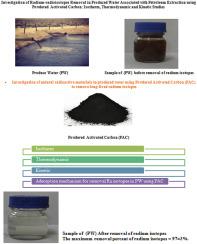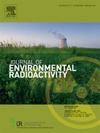Investigation of radium-radioisotopes removal in produced water associated with petroleum extraction using powdered activated carbon: Isotherm, thermodynamic and kinetic studies
IF 2.1
3区 环境科学与生态学
Q3 ENVIRONMENTAL SCIENCES
引用次数: 0
Abstract
The huge volume waste of the produced water (PW) associated with petroleum extraction poses significant hazards to the surrounded environment due to its complex composition and the presence of various hazardous pollutants, including organic, inorganic, biological contaminants, and natural occurring radioactive materials (NORM). This study was conducted to investigate the factors affecting the removal of the long-lived radium isotopes, i.e., 226Ra (1600 y) and 228Ra (5.8 y), from PW associated with oil and natural gas production in certain Egyptian oilfield. The total radium concentration (226Ra + Ra228) in PW was found to be 164 Bq/L, i.e., 3.145 ng/L. Isotherm, thermodynamic, kinetic and adsorption mechanism were carried out for the removal of Ra-isotopes in PW using powdered activated carbon (PAC) as adsorbent material. The removal efficiency of Ra-isotopes was found to be affected by pH, adsorbent dosage, temperature, and contact time. The maximum removal efficiency exceeded 97 ± 3 % under optimal conditions (pH∼5, 23 ± 2 °C and 3 h contact time). Moreover, it was revealed that the adsorption mechanism of Ra isotopes removal in PW is heterogeneous process controlled by both Freundlich (R2 = 0.998) and Dubinin-Radushkevich (R2 = 0.970) isotherms. The process followed the pseudo-second-model (R2 = 0.998), and was endothermic up to temperatures below 40 °C. At the optimal conditions, the maximum adsorption capacity (qe) of Ra from PW onto PAC reached 0.77 ng/g (40 Bq/g) after 3 h at pH 5 0.02 and 23 2 °C. At these conditions, removal of Ra-isotopes from PW using PAC could be mainly due to surface complexation mechanism. As a result, the activity concentration (Bq/L) and natural radiation dose rate ( Sv/h) of total radium (226Ra + 228Ra) in PW were reduced below the exemption limits (<10 Bq/L, <0.1 Sv/h) recommended internationally. Furthermore, the data is efficient and promising for designing a prototype for NORM removal from PW generated in petroleum industry prior to its discharge into the surrounded environment.

粉末状活性炭去除石油采出水中镭放射性同位素的研究:等温线、热力学和动力学研究
与石油开采相关的大量产出水(PW)由于其复杂的成分和各种有害污染物的存在,包括有机、无机、生物污染物和天然存在的放射性物质(NORM),对周围环境造成了重大危害。本研究旨在探讨影响埃及某油田从与石油和天然气生产有关的PW中去除长寿命镭同位素,即226Ra (1600 y)和228Ra (5.8 y)的因素。PW中总镭浓度(226Ra + Ra228)为164 Bq/L,即3.145 ng/L。采用粉状活性炭(PAC)作为吸附剂,研究了粉末活性炭去除PW中ra同位素的等温线、热力学、动力学和吸附机理。结果表明,pH、吸附剂投加量、温度和接触时间对ra同位素的去除率均有影响。在最佳条件下(pH ~ 5, 23±2℃,接触时间3 h),最大去除率超过97±3%。此外,还发现PW对Ra同位素的吸附机制是由Freundlich (R2 = 0.998)和Dubinin-Radushkevich (R2 = 0.970)等温线控制的非均相过程。该过程符合拟第二模型(R2 = 0.998),在温度低于40℃时为吸热过程。在最佳条件下,在pH为5±0.02和23±2℃的条件下,PW对PAC的最大吸附量(qe)为0.77 ng/g (40 Bq/g)。在这些条件下,用PAC去除PW中的ra同位素可能主要是由于表面络合机制。结果,PW中总镭(226Ra + 228Ra)的活度浓度(Bq/L)和自然辐射剂量率(μ Sv/h)均低于国际推荐的豁免限值(10 Bq/L, 0.1 μ Sv/h)。此外,这些数据对于设计石油工业废水排放到周围环境之前的NORM去除原型是有效的和有希望的。
本文章由计算机程序翻译,如有差异,请以英文原文为准。
求助全文
约1分钟内获得全文
求助全文
来源期刊

Journal of environmental radioactivity
环境科学-环境科学
CiteScore
4.70
自引率
13.00%
发文量
209
审稿时长
73 days
期刊介绍:
The Journal of Environmental Radioactivity provides a coherent international forum for publication of original research or review papers on any aspect of the occurrence of radioactivity in natural systems.
Relevant subject areas range from applications of environmental radionuclides as mechanistic or timescale tracers of natural processes to assessments of the radioecological or radiological effects of ambient radioactivity. Papers deal with naturally occurring nuclides or with those created and released by man through nuclear weapons manufacture and testing, energy production, fuel-cycle technology, etc. Reports on radioactivity in the oceans, sediments, rivers, lakes, groundwaters, soils, atmosphere and all divisions of the biosphere are welcomed, but these should not simply be of a monitoring nature unless the data are particularly innovative.
 求助内容:
求助内容: 应助结果提醒方式:
应助结果提醒方式:


